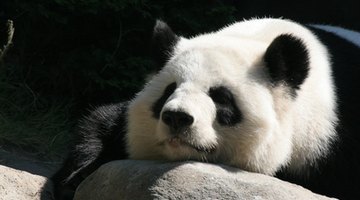According to A Visual Sourcebook for Chinese Civilization, an online project of the U.S. National Endowment for the Humanities, the Yangtze River is the longest river in China and the third-longest river in the world. Almost 4,000 miles long, the river runs through nine provinces. There are hundreds of plant and animal species in and around the Yangtze, including some that are unique to China.
Chinese Giant Salamander
Chinese giant salamanders are found in several places in China, including in and around the Yangtze River. They live both in the water and in muddy cracks and under rocks along the river banks. The largest salamander in the world, this amphibian can grow to nearly 6 feet in length. It eats worms, smaller salamanders, snails and crayfish. The salamander typically waits for prey to come close enough to be captured by a rapid sideways snap of its head. The Chinese giant salamander is considered to be a critically endangered species.
- Chinese giant salamanders are found in several places in China, including in and around the Yangtze River.
- The Chinese giant salamander is considered to be a critically endangered species.
Giant Panda

These black and white bears can be as large as 113 Kilogram. According to the World Wildlife Fund (WWF), the giant panda is an endangered species that lives in rugged, mountainous areas of China, including along the Yangtze River. Giant pandas exist almost entirely on bamboo, despite the fact that they still have a digestive system more suited to carnivores. These animals do eat small amounts of other food, mostly grass, and sometimes musk deer fawns and small rodents. The WWF estimates there are only 1,600 giant pandas left in the wild.
- These black and white bears can be as large as 113 Kilogram.
- According to the World Wildlife Fund (WWF), the giant panda is an endangered species that lives in rugged, mountainous areas of China, including along the Yangtze River.
Mother Chrysanthemum

This large flower is a variety of chrysanthemum that grows wild in dry, rocky pockets along the Yangtze River. It comes in many different colours, especially pale yellow, orange, and gold. Larger than many other chrysanthemums, these plants can grow to 5 feet tall, with blossoms that can be as much as 7 inches across. Some think this flower is called "mother" because of its size, and others say it is because of where it grows, as the Yangtze is sometimes called the Mother River of China. This flower is often used in traditional Chinese medicine for a variety of ills, including as a treatment for cancer. Parts of the flower are also used to make an energy-boosting tea. An infusion of these flowers can be used topically to treat sore eyes or consumed as a medicine for headaches, colds, and flu.
- This large flower is a variety of chrysanthemum that grows wild in dry, rocky pockets along the Yangtze River.
- This flower is often used in traditional Chinese medicine for a variety of ills, including as a treatment for cancer.
Dove Tree

This beautiful tree has pure white flowers called dove flowers that resemble doves perched in the branches. This tree is very rare and exists only in a few areas near the Yangtze River and the Shennong Stream, a tributary of the Yangtze. Since doves are a symbol of peace, the Chinese government presents this tree as a gift to representatives of other countries as a symbol of friendship. Representatives from countries on six different continents have been given the gift of a dove tree.
- This beautiful tree has pure white flowers called dove flowers that resemble doves perched in the branches.
- Since doves are a symbol of peace, the Chinese government presents this tree as a gift to representatives of other countries as a symbol of friendship.
Chinese Grouse
Growing to just 13 inches long, the Chinese grouse is the smallest grouse in the world. These birds live in the birch and coniferous forests in and around the Yangtze River at altitudes above 3,000 feet. This bird has black barring on its back, belly and tail, with a brown base colour. Its chest is a reddish-brown, and its black throat is bordered by white. It also has a prominent white spot behind each eye. This species is considered endangered due to fragmentation of habitat.
- Growing to just 13 inches long, the Chinese grouse is the smallest grouse in the world.
- This bird has black barring on its back, belly and tail, with a brown base colour.
